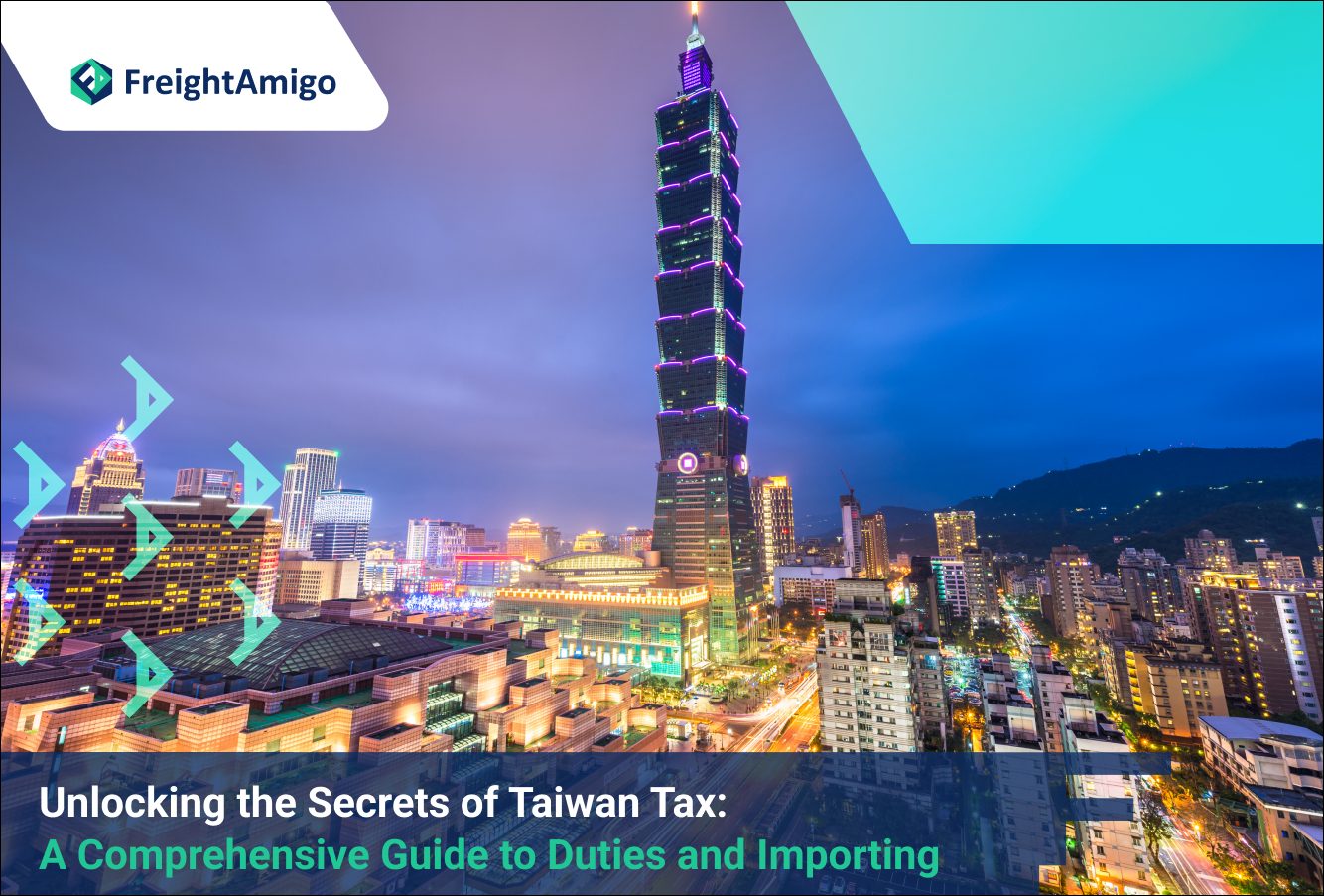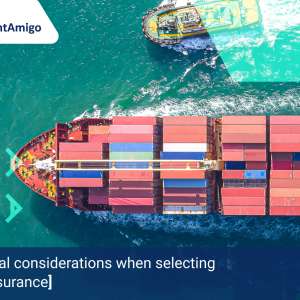Author Name: Tiffany Lee – Marketing Analyst at FreightAmigo
Navigating the intricate landscape of Taiwan tax, especially in the context of duties and importing goods, presents a formidable challenge to businesses and individuals aiming to engage in international commerce with this dynamic Asian market. The complexity of Taiwan’s import duty structure, compounded by the varying rates of income tax and other levies, necessitates a comprehensive understanding for efficient and compliant trade operations. This knowledge is not only vital for optimizing cost efficiency but also for ensuring adherence to local regulatory mandates, thereby avoiding costly penalties and delays.
This guide endeavors to demystify the nuances of Taiwan’s tax system, focusing on key areas such as understanding Taiwan’s import duty structure, essential documentation required for importing goods, strategies for managing duties and taxes effectively, and navigating the tax-free threshold. By offering a roadmap through these critical aspects, FreightAmigo aims to empower traders and businesses with the insights needed to navigate the Taiwan tax system confidently.
Want To Compare The Best Express, Air Freight, Sea Freight, Rail Freight & Trucking Rates So As To Have Better Control On Cost?
Understanding Taiwan’s Import Duty Structure
Taiwan’s compliance with WTO and its impact
Since joining the World Trade Organization (WTO) in 2002, Taiwan has aligned its trade policies with international standards, significantly impacting its import duty structure. Compliance with WTO mandates has required Taiwan to lower tariff rates and eliminate non-tariff barriers, fostering a more open trade environment. This integration into the global trade system underscores Taiwan’s commitment to facilitating international commerce by adhering to agreed-upon rules and regulations.
Harmonized Commodity Description and Coding System
Taiwan employs the Harmonized Commodity Description and Coding System (HS) for classifying imported goods, a practice shared by over 200 countries. The HS system, developed by the World Customs Organization, organizes goods based on their characteristics and intended use, assigning unique codes to identify and apply the correct import duties. This standardized classification system plays a crucial role in streamlining customs procedures and enhancing trade efficiency.
Current average nominal tariff rates
According to recent data, Taiwan’s average nominal tariff rate stands at approximately 6.1%. However, it’s important to note the variation in tariff rates depending on the specific product category. Industrial products, for example, have an average nominal tariff rate of 4.13%, while agricultural products are subject to a higher rate of 15.06%. These rates reflect Taiwan’s efforts to balance protecting domestic industries with promoting international trade through its tariff structure.
Key Documentation for Importing Goods to Taiwan
Required Documentation Overview
In Taiwan, the importation process is streamlined under the Foreign Trade Act, allowing most commodities to be imported freely without specific permits or licensing. However, exceptions exist for items on the Negative List due to their potential impact on national defense, social stability, and environmental health. For these, permits or licensing from the Bureau of Foreign Trade are mandatory. Essential documents for customs clearance include a foreign supplier’s pro forma invoice, commercial invoice, bill of lading or airway bill, and packing list. Certain commodities also require a certificate of origin and, for agricultural products, plants, and animals, certificates of inspection or quarantine from the country of origin.
Understanding the Import Customs Clearance Process
- Present necessary documents at the customs import counter, including passport or photo ROC ID, airway bill, invoice or proof of purchase, packing list, and import permit if required.
- A customs officer assists with the declaration form, with a NT$200 fee for data key-in service.
- Open the package for inspection by the customs officer.
- Await document review by the customs officer.
- Pay taxes and warehouse fees on site.
- Collect your goods. Documents must be prepared in Chinese to expedite clearance processing, and electronic declarations are encouraged for efficiency.
Working with Customs Brokers
While not legally required, many importers choose to work with Customs Brokers for convenience. These professionals are licensed to conduct customs business on behalf of importers, handling paperwork and obtaining a CBP bond. Importers remain responsible for ensuring compliance with all regulations, but brokers can prevent costly mistakes. For those importing via express couriers like FedEx or DHL, the courier typically utilizes Customs Brokers automatically. Importers should compare broker services and costs, as charges for their services vary.
Strategies for Managing Duties and Taxes
Using the CIF method effectively
Taiwan employs the Cost, Insurance, and Freight (CIF) method for calculating duties and taxes on imported goods. This approach considers the value of the goods plus the cost of shipping and insurance to determine tax liabilities. To utilize the CIF method effectively, importers should ensure that all components—cost of the product, insurance fees, and freight charges—are accurately declared. Misrepresentation can lead to penalties or delays. The CIF method’s correct application can result in more predictable and, sometimes, lower duty and tax obligations, especially when the total CIF value remains below Taiwan’s de minimis threshold of 2,000 TWD.
Leveraging bulk shipping for deeper discounts
Bulk shipping, particularly direct injection, offers significant advantages for managing duties and taxes on imports to Taiwan. By consolidating shipments, businesses can achieve deeper discounts and potentially benefit from exceptions for import taxes and duties. This strategy is particularly effective for high-volume traders looking to minimize costs associated with duties and taxes. Direct injection, a form of consolidated shipping, requires a minimum of 250 orders but can significantly reduce the landed cost per unit, making it an attractive option for businesses aiming to optimize their import strategies in Taiwan.
Importance of accurate value declaration
Accurate value declaration is critical for managing duties and taxes efficiently. Misunderstandings regarding the commodity’s value can lead to incorrect duty and tax assessments, affecting overall costs. Importers should avoid extremes, such as declaring a returned item as having zero value or assuming the purchase price is the item’s value for duty purposes. Instead, the declared value should reflect the actual transaction value, considering any adjustments as required by Taiwan’s tax regulations. Accurate value declaration, combined with proper classification and understanding of trade agreements, can lead to significant savings and smoother customs processing.
Navigating the Tax-Free Threshold
Explanation of the 2000 TWD Threshold
Taiwan’s tax-free threshold for imports is set at TWD 2000. This means that goods valued below this amount are exempt from import duties and taxes. The threshold is determined based on the CIF (Cost, Insurance, and Freight) value of the order. For shipments exceeding this value, duties and taxes apply, making it crucial for importers to accurately assess the value of their goods.
Impact on Small Shipments
For small shipments, this de minimis threshold offers a significant advantage. Items valued under TWD 2000 can be imported into Taiwan without incurring additional charges, facilitating a more cost-effective process for individuals and businesses dealing with low-value imports. This exemption, however, is exclusive, as there is no free trade agreement between Taiwan and certain countries, such as Malaysia, which means all eligible goods can benefit from this duty exemption regardless of their origin.
Strategies to Minimize Taxes Legally
- Accurate Declaration: Ensure that the value of goods, along with shipping and insurance costs, are precisely declared to leverage the tax-free threshold effectively.
- Bulk Shipping: Consider consolidating shipments to take advantage of bulk discounts and minimize the per-unit cost, staying below the de minimis value.
- Understand Regulations: Familiarize yourself with Taiwan’s import regulations and exemptions to navigate the tax-free threshold strategically.
| Strategy | Description |
|---|---|
| Accurate Declaration | Declare the true value of goods, including shipping and insurance, to avoid penalties and leverage the tax-free threshold. |
| Bulk Shipping | Consolidate orders to reduce per-unit cost, potentially keeping the total CIF value below TWD 2000. |
| Understanding Regulations | Stay informed about Taiwan’s import regulations and exemptions to maximize tax savings. |
By employing these strategies, importers can navigate Taiwan’s tax-free threshold effectively, minimizing duties and taxes legally.
Conclusion
Through a thorough exploration of Taiwan’s tax landscape, specifically focusing on duties and importing goods, we’ve unveiled the intricate details pivotal for businesses and individuals aiming to penetrate this dynamic market. From understanding the import duty structure and necessary documentation to strategizing on managing duties and taxes effectively, this guide serves to demystify the complexities involved. It accentuates the importance of being well-prepared and informed, highlighting that successful navigation through Taiwan’s tax system not only enhances cost efficiency but also ensures compliance with local regulatory standards.
Reflecting on the broader implications, the insights provided bear significant relevance for those engaged in international commerce with Taiwan. By applying the strategies discussed, such as leveraging the CIF method and understanding the tax-free threshold, traders can optimize their operations to reap maximum benefits. As the global trade landscape continues to evolve, staying abreast of such regulatory environments is crucial. Therefore, while this article furnishes an essential foundation, continuous learning and adaptation to the ever-changing tax and duty regulations remain indispensable for sustained success in the international market.
There Are Different Options For Cargo Transportation. If You Want To Choose The Most Convenient And Suitable Solution, It Is Best To Have The Full Support Of Logistics Experts! If You Are Planning To Ship Goods Overseas, Please Go To The FreightAmigo Page For Inquiries.
===
Read More:
【Cosmetic Product Recycling】 A Guide to Sustainable Reverse Logistics
【Rise of Green Supply Chain】 Pioneering Sustainable Practices in Logistics
【ESG in Logistics】 How ESG Practices Drive Social Responsibility in Logistics
===
If you have any inquiries on logistics/supply chain, feel free to contact FreightAmigo now:
Chat with us online OR
Phone : +852 28121686
WhatsApp: +852 27467829









































